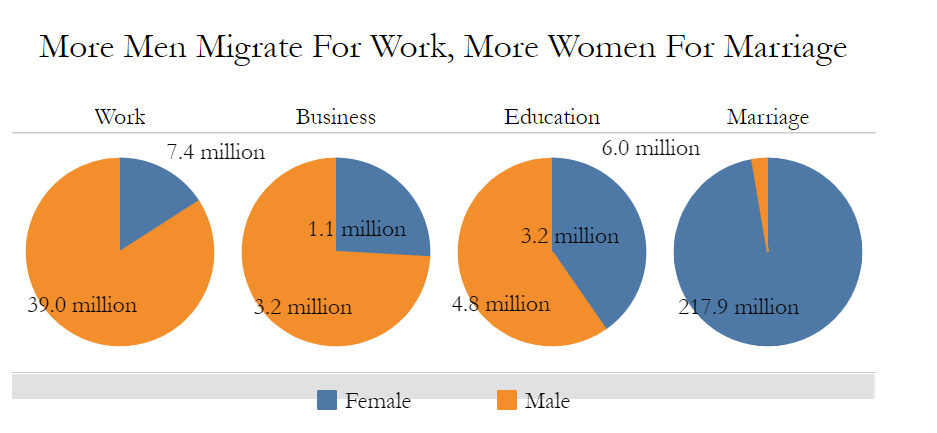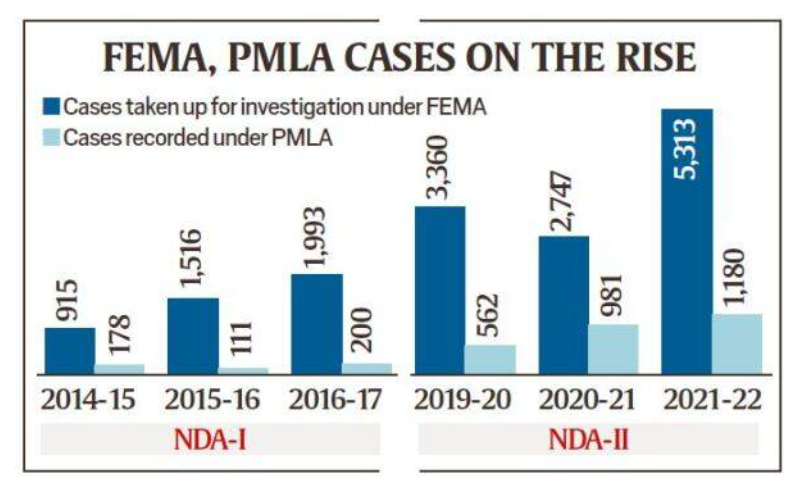CONTENTS
- A Blurred Mapping of Internal Female Migration
- Change in Jharkhand
A Blurred Mapping of Internal Female Migration
Context:
Internal migration holds significant importance as a vital aspect of physical and social movement in India. The Periodic Labour Force Survey (PLFS) has reported a migration rate of 27% from June 2020 to 2021. It is noteworthy that women, particularly those of working age, constitute a considerable portion of this migrant population. Despite this, there is a lack of substantial discourse surrounding the experiences of female migrants.
Relevance:
GS-1
- Issues Related to Women
- Role of Women
GS- 3
- Liberalization
- Growth & Development
Mains Question:
Women, especially of working age, comprise a greater share of India’s migrant pool but there is little dialogue and flawed data on this important issue. Analyse. (15 Marks, 250 Words).
Understanding Women Migration:
| Surveys on Women Migration | National surveys, although informative, may present an inaccurate portrayal of female migration. For instance, the PLFS primarily asks respondents about their primary reason for migration. According to PLFS data, the primary reasons for women’s migration are cited as marriage (81%), followed by family members’ migration (10%), employment (2.42%), and migration for educational opportunities (0.48%). Unfortunately, these surveys often do not delve into secondary reasons or motivations, such as climate shocks and food insecurity, which can significantly influence women’s migration patterns. A significant catalyst for women’s migration is often not accurately captured by data from these surveys. According to the PLFS, about three-quarters of migrant women are reported as unemployed, around 14% are engaged in self or wage-employed positions, and approximately 12% are in casual labor. While the PLFS data implies a considerable number of unemployed migrant women, anecdotal evidence and research suggest that many migrant women are involved in casual employment, such as agriculture, construction, and domestic help, indicating an underestimation of their presence in various sectors. Despite the sparse formal representation of migrant women in the labor force, female migration for labor/employment witnessed a 101% increase between 2001 and 2011. Nevertheless, these women often remain invisible, encountering significant obstacles and marginalization. |
| Underreporting of Employment Among Migrant Women | Two primary factors contribute to the underreporting of employment among migrant women. Firstly, the reliance on definitional criteria and women’s own beliefs results in an underestimation of their employment status. National surveys define employment based on individuals with some form of verbal or written contract with their employer, leading to the classification of many women as unemployed. However, what often goes unnoticed is that women tend to opt for types of employment that allow them to manage their domestic responsibilities while still contributing to the household’s production or finances. As a result, engaging in unpaid family work, participating in household enterprises, or being self-employed is a common choice among them, as highlighted by S. Rukmini (2023). However, they may perceive these roles as extensions of their domestic commitments rather than distinct forms of employment, leading to misreporting of their employment status. Despite these considerations, if gaining entry into the formal labor force is indeed challenging, a key factor limiting their participation could be the necessity for greater human and social capital. |
| Education Levels of Women | According to PLFS data, 85% of women have less than 10 years of education, posing potential challenges. While there is no substantial difference in the educational levels between migrant and non-migrant women, migrant women are comparatively less employed than their non-migrant counterparts. When coupled with the absence of robust social networks, particularly following migration, these factors can significantly impede their chances of securing employment. These obstacles could also account for the disappointing resurgence in women’s labor participation after the pandemic. |

Way Forward:
- National surveys need to gather more comprehensive information about the socioeconomic conditions of migrant women post-migration, as there is limited knowledge in this area.
- For example, the PLFS indicates that only a small percentage (around 7%) of migrant women have access to social security benefits, with no available data for the remaining population.
- Moreover, there is a lack of time-use data for migrants, which could significantly enhance understanding of unemployed female migrants.
Conclusion:
On a broader scale, there is a need for a change in the narrative, beginning with an increased collection of female-specific data. This approach will shed light on the largely anecdotal issue, raising awareness about the challenges faced by these women and encouraging the development of progressive policies.
Change in Jharkhand
Context:
Hemant Soren, the leader of Jharkhand Mukti Morcha (JMM), resigned as the Chief Minister of Jharkhand on Wednesday just moments before the Enforcement Directorate (ED) arrested him on charges of money laundering. He is accused of benefiting from tribal land transactions based on forged documents. The judiciary will examine these allegations, raising the question of what justifies the arrest of an accused person, a matter that the judiciary needs to address with clearer and enforceable terms.
Relevance:
GS-2
- Government Policies and Interventions
- Issues and Challenges Pertaining to the Federal Structure
GS-3 Money Laundering
Mains Question:
With reference to the recent political turmoil in Jharkhand, discuss the extent of autonomy exercised by the independent agencies like Enforcement Directorate in India.
Enforcement Directorate (ED):
- The Enforcement Directorate (ED) is a diverse organization tasked with investigating money laundering offenses and violations of foreign exchange laws.
- It operates under the Department of Revenue within the Ministry of Finance. As a prominent financial investigation agency of the Indian government, the Enforcement Directorate strictly adheres to the Constitution and laws of India.
- The ED’s roots can be traced back to May 1, 1956, when an ‘Enforcement Unit’ was established in the Department of Economic Affairs to handle violations of Exchange Control Laws under the Foreign Exchange Regulation Act (FERA) of 1947.
- Initially headquartered in Delhi and led by a Legal Service Officer as the Director of Enforcement, it had branches in Bombay and Calcutta. In 1957, the unit was renamed the ‘Enforcement Directorate,’ and a new branch was opened in Madras (now Chennai).
- In 1960, the administrative control of the Directorate shifted from the Department of Economic Affairs to the Department of Revenue.
- Over time, the FERA of 1947 was replaced by the FERA of 1973. With the advent of economic liberalization, the regulatory FERA of 1973 was repealed, giving way to the Foreign Exchange Management Act, 1999 (FEMA), effective from June 1, 2000.
- Aligned with the International Anti Money Laundering regime, the Prevention of Money Laundering Act, 2002 (PMLA) was enacted. The Enforcement Directorate was entrusted with its enforcement from July 1, 2005.
- Under the Prevention of Money Laundering Act (PMLA), the ED holds extensive powers of arrest, and obtaining bail in PMLA cases is challenging. There are pending petitions challenging the Supreme Court’s July 2022 judgment upholding these powers.
- The ED’s arrest of an Opposition party Chief Minister, Mr. Soren, adds significance to the situation, going beyond a routine law enforcement event.
- His lawyers emphasized in court on February 1 that the arrest has implications for the country’s political system, urging an urgent hearing for his plea.
- Simultaneously, the ED has summoned Delhi Chief Minister and Aam Aadmi Party leader Arvind Kejriwal to appear before it on February 2 after he failed to attend questioning four times.

- Mr. Soren has framed the case against him as an assault on the tribal communities he represents, calling for a “war against a feudal system” that oppresses the poor, Dalits, and tribals.
- When faced with allegations, politicians frequently resort to shielding themselves through their community affiliations, yet it is undeniable that the Indian legal system more readily reaches the marginalized sections of society.
- The JMM’s challenges extended beyond Mr. Soren’s arrest. The process of selecting a new Chief Minister became complicated due to a family dispute.
- As a compromise, Champai Soren, a seasoned advocate for tribal rights, is expected to assume the role, although the Governor has not extended an invitation for him to form the government.
- The Jharkhand police initiated a First Information Report (FIR) based on Mr. Soren’s complaint under the SC/ST (Prevention of Atrocities) Act, but its viability is uncertain.
- Nevertheless, ED investigations have identified a consistent pattern aligning with the political objectives of the ruling Bharatiya Janata Party (BJP).
Conclusion:
Mr. Soren’s arrest comes on the heels of the reconfiguration of the alliance in Bihar, facilitating the BJP’s return to power, with the Governor acting swiftly in support. Instances abound where leaders under the ED’s scrutiny seemingly cleanse their image upon aligning with the BJP. At times, the distinction made by central agencies seems to hinge not on whether someone is corrupt or clean, but rather on their affiliation with the BJP.




